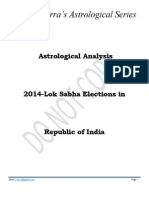KCD, Kalachakra Dasa
KCD, Kalachakra Dasa
Uploaded by
Vivek PadhyeCopyright:
Available Formats
KCD, Kalachakra Dasa
KCD, Kalachakra Dasa
Uploaded by
Vivek PadhyeOriginal Description:
Original Title
Copyright
Available Formats
Share this document
Did you find this document useful?
Is this content inappropriate?
Copyright:
Available Formats
KCD, Kalachakra Dasa
KCD, Kalachakra Dasa
Uploaded by
Vivek PadhyeCopyright:
Available Formats
Introduction
Maharshi Parasara taught tens of dasa systems in Brihat Paaraasara Horaa Saastram. He only taught the calculations and did not elaborate the purpose and use of each dasa. He probably expected the learners to figure them out. Kaala dasa and Chakra dasa were two of the dasas taught by him. Kaala means time and chakra means wheel. In this article, we will look into those two dasas. Kaala dasa and Chakra dasa are both of 120 years and both are based the division of the day into 4 parts. While Kaala dasa is of planets, Chakra dasa is of signs. My view is that these two dasas are to be combined and used together. It must be clarified that this article is not based on any secret knowledge preserved in a parampara or on any long and extensive research project. Though the calculations presented in this article are based on Parasaras unambiguous teachings, the judgment of results is based on my insights after meditating on the verses of Parasara and some limited research that followed. When the ideas were tested with a few charts, there were very interesting results. The research was not extensive, but I feel that it is significant enough to share with others. With the limited time I have, I may not be able to do any further justice to these findings. If my findings are recorded, I hope that some keen students of Jyotish will study this research in future and refine the knowledge.
Four Parts of the Day
These two dasas depend on the division of the day into four parts (1) morning sandhya (dawn) time, (2) day time, (3) evening sandhya (dusk) time, and (4) night time. Sunrise is the time when the center of Sun is exactly on the eastern horizon, i.e. lagna and Sun are exactly conjoined. Sunset is the time when the center of Sun is exactly on the western horizon, i.e. lagna is exactly 180 degrees from Sun. If we divide the time period from sunrise to sunset into six equal parts, the first part belongs to dawn, the next four parts constitute the daytime and the last part belongs to dusk. If we divide the time period from sunset to the next sunrise into six equal parts; the first part belongs to dusk; the next four parts constitute the nighttime; and, the last part belongs to the dawn (of the next day). Suppose sunrise happens at 6 am and sunset happens at 6pm everyday. Then dawn is from 4 am to 8 am, daytime is from 8 am to 4 pm, dusk is from 4 pm to 8 pm and nighttime is from 8 pm to 4 am.
Computation of Kaala Dasa
In Kaala dasa, dasas always start with Sun dasa and go as Sun, Moon, Mars, Mercury, Jupiter, Venus, Saturn, Rahu and Ketu. There are two cycles of these nine dasas. All the eighteen dasas together give 120 years. Find the fraction that has elapsed in the portion of the day (dawn or day or dusk or night). The first cycle of nine dasas gives the same fraction of 120 years. Then find the fraction that is yet to come in the portion of the day. The second cycle of nine dasas gives the same fraction of 120 years. Suppose sunrise is at 6 am and sunset is at 6 pm. Suppose someone is born at 5 pm. Evening sandhya (dusk) starts at 4 pm and lasts till 8 pm. So birth happened in sandhya. The length of this portion of the day is 4 hours. Out of it, 1 hour has elapsed at 5 pm. This is one-fourth of the entire length of the portion of the day (dusk). Then one-fourth of 120 years, i.e. 30 years, is the length of the first cycle of nine dasas. The length of the second cycle of nine dasas is 90 years. In each cycle, the length of the cycle is divided by 45 to get the length of the first dasa of Sun. It is multiplied by 2, 3, 4, 5, 6, 7, 8 and 9 to get the lengths of Moon, Mars, Mercury, Jupiter, Venus, Saturn, Rahu and Ketu dasas (respectively). Table 1: Dasa Lengths (F = length of first cycle in years) DASA ORDER (1) Sun (2) Moon (3) Mars (4) Mercury (5) Jupiter (6) Venus (7) Saturn (8) Rahu (9) Ketu DASA LENGTH IN 1ST CYCLE (F / 45) 2 x (F / 45) 3 x (F / 45) 4 x (F / 45) 5 x (F / 45) 6 x (F / 45) 7 x (F / 45) 8 x (F / 45) 9 x (F / 45) DASA LENGTH IN 2ND CYCLE ((120F) / 45) 2 x ((120F) / 45) 3 x ((120F) / 45) 4 x ((120F) / 45) 5 x ((120F) / 45) 6 x ((120F) / 45) 7 x ((120F) / 45) 8 x ((120F) / 45) 9 x ((120F) / 45)
Let us take the first cycle in the above example. The length of the first cycle of nine dasas is 30 years. If we divide it by 45, we get 2/3 year. So Sun dasa is of 2/3 year, i.e. 8 months. Moon dasa is 2 x 2/3 = 1 1/3 year, i.e. 1 year 4 months. Mars dasa is 3 x 2/3 = 2 years. Mercury dasa is of 4 x 2/3 = 2 2/3 years, i.e. 2 years 8 months. And so on. Let us take the second cycle in the above example. The length of the second cycle of nine dasas is 90 years. If we divide it by 45, we get 2 years. So the dasas of Sun, Moon, Mars, Mercury, Jupiter, Venus, Saturn, Rahu and Ketu are of 2, 4, 6, 8, 10, 12, 14, 16 and 18 years
(respectively).
You might also like
- Rinri III 1.2Document18 pagesRinri III 1.2Diego AlfaroNo ratings yet
- Hair Transplantation-Informa Healthcare 5th Ed. (2011)Document556 pagesHair Transplantation-Informa Healthcare 5th Ed. (2011)Ferdie YuzonNo ratings yet
- Sample Motion To Dismiss DesistanceDocument1 pageSample Motion To Dismiss Desistancemarilyn domalaon100% (2)
- Inventing The Opera HouseDocument276 pagesInventing The Opera HouseIvánNo ratings yet
- G.R. No. 17958Document2 pagesG.R. No. 17958Pawix 55100% (1)
- Born Innocent by Carole ZilliacusDocument88 pagesBorn Innocent by Carole ZilliacusShelia IstifNo ratings yet
- A Brief Look at The Twelve Lagnas/ Ascendants in Vedic AstrologyDocument13 pagesA Brief Look at The Twelve Lagnas/ Ascendants in Vedic AstrologyKrishna CHNo ratings yet
- What Is Meant by Vaiseshikamsa - Jyotish - Vedic AstrologyDocument1 pageWhat Is Meant by Vaiseshikamsa - Jyotish - Vedic AstrologySamar Vaishampayan50% (2)
- 21 SimilarityBetweenQuantumMechanicsAstrologyDocument7 pages21 SimilarityBetweenQuantumMechanicsAstrologySudhir Kumar PandeyNo ratings yet
- Leo, Alan - 1906 - The Horoscope in DetailDocument117 pagesLeo, Alan - 1906 - The Horoscope in DetailKoayeNo ratings yet
- Importance of Divisional Charts in Vedic AstrologDocument10 pagesImportance of Divisional Charts in Vedic Astrologanimesh dasNo ratings yet
- Kalam ChartDocument3 pagesKalam ChartSachin MakhijaNo ratings yet
- JKR Astro Research Foundation TIME in HINDUISM - Compiled by C S ChalamDocument5 pagesJKR Astro Research Foundation TIME in HINDUISM - Compiled by C S ChalamjeydownloadNo ratings yet
- Mercury Meets Sun in AquariusDocument5 pagesMercury Meets Sun in AquariusTom SharplesNo ratings yet
- The Messageofthe StarsDocument703 pagesThe Messageofthe StarsAbhi AbhijithNo ratings yet
- Full Moon - Sesame BathDocument2 pagesFull Moon - Sesame Bathႏ်ဴမာန္ မိုးတားNo ratings yet
- Chapter 3 - Planets - AstroBasicDocument6 pagesChapter 3 - Planets - AstroBasicvganapathy1000No ratings yet
- The Solar System:: TH THDocument11 pagesThe Solar System:: TH THGudiya GuptaNo ratings yet
- Sati Grid - Reiki RaysDocument5 pagesSati Grid - Reiki RaysBharat KumarNo ratings yet
- Chronicles of The Celestial Scribes Secrets of The Starlight ScrollsDocument2 pagesChronicles of The Celestial Scribes Secrets of The Starlight ScrollsBeni100% (1)
- The Living Name: A Guide To Chanting With AbsorptionDocument3 pagesThe Living Name: A Guide To Chanting With AbsorptionRadharani rasasNo ratings yet
- Astrology & Its Connection With Vedanta - C Venkatarava (1899)Document65 pagesAstrology & Its Connection With Vedanta - C Venkatarava (1899)Justinian BaraitaruNo ratings yet
- 13 PlanetsDocument27 pages13 PlanetsRajender SalujaNo ratings yet
- Sadhguru Explores The Nature of Geometry and ArchitectureDocument1 pageSadhguru Explores The Nature of Geometry and ArchitectureAnonymous Dq88vO7aNo ratings yet
- 10 Dimensions: 0th DimensionDocument4 pages10 Dimensions: 0th DimensionIblis Shai100% (1)
- Entropy of The UniverseDocument15 pagesEntropy of The UniverseAnkur AhlawatNo ratings yet
- Colors VastuDocument17 pagesColors Vastuwestway NOIDANo ratings yet
- Vedic Astrology Section Report English EI PDFDocument376 pagesVedic Astrology Section Report English EI PDFaniruddha prabhuNo ratings yet
- Sri Sarv Kasht Nivaran Yantra Is To Remove All Obstacles and ProblemsDocument10 pagesSri Sarv Kasht Nivaran Yantra Is To Remove All Obstacles and Problemsspirit571No ratings yet
- BB Meanyr LN Cyls Tithi CountDocument4 pagesBB Meanyr LN Cyls Tithi CountRajender SalujaNo ratings yet
- The Karakas IDocument9 pagesThe Karakas Imanishlekhwar3363100% (1)
- Gochara Phala File 01docxDocument18 pagesGochara Phala File 01docxdeepaktaleleNo ratings yet
- The Rational Nature of ManDocument17 pagesThe Rational Nature of ManLuna TremeniseNo ratings yet
- Modern Approach To AstrologyDocument7 pagesModern Approach To AstrologymprnairNo ratings yet
- The Three Gunas of MayaDocument10 pagesThe Three Gunas of MayaSocrates NirbhayaNo ratings yet
- Sharda TilakDocument135 pagesSharda TilakAayushi TayalNo ratings yet
- Astrology E-Brochure IvaDocument12 pagesAstrology E-Brochure IvaAnil KumarNo ratings yet
- Santhosh HoroscopeDocument24 pagesSanthosh HoroscopeNanda KumarNo ratings yet
- List of ConjunctionsDocument20 pagesList of ConjunctionsJagmohan Chandra Pathak0% (1)
- 3030 Ancient Indian MathematicsDocument3 pages3030 Ancient Indian MathematicsMeeNu KarthikNo ratings yet
- Geometry and AstrologyDocument6 pagesGeometry and AstrologyVikas SuryavanshiNo ratings yet
- Astrological Analysis 2014-LokSabha Elections in India - Republic of IndiaDocument10 pagesAstrological Analysis 2014-LokSabha Elections in India - Republic of IndiaSastry Karra100% (1)
- Lords FriendshipsDocument1 pageLords Friendshipspurinaresh85100% (1)
- 108 & IobDocument75 pages108 & IobAnonymous 3pTM9WCYNo ratings yet
- Golden Mountain of Sri YantraDocument75 pagesGolden Mountain of Sri YantraUday DokrasNo ratings yet
- #Zodiax 1622 #AcademicZodiac 1008Document16 pages#Zodiax 1622 #AcademicZodiac 1008Antonio SolisNo ratings yet
- A Vedic Key To The ZodiacDocument5 pagesA Vedic Key To The ZodiacHoracio Tackanoo100% (1)
- Hindu Deities - Know and Follow Hindu Dharma BlogDocument268 pagesHindu Deities - Know and Follow Hindu Dharma Bloggokuboy1der0% (1)
- Dimbha ChakramDocument4 pagesDimbha ChakramAdithya VishakhaNo ratings yet
- 2 ClearingYourSpaceDocument1 page2 ClearingYourSpacemiahi gadNo ratings yet
- Match Making 4Document5 pagesMatch Making 4Subramanya RaoNo ratings yet
- Advanced Astrology Chart - Part 1Document11 pagesAdvanced Astrology Chart - Part 1BC AmrathaNo ratings yet
- Astrological InheritanceDocument10 pagesAstrological Inheritancesarvadu100% (1)
- Neechcha Uchcha Rahu-Ketu Debilitated Exalted Rahu-Ketu - BP Lama JyotishaDocument5 pagesNeechcha Uchcha Rahu-Ketu Debilitated Exalted Rahu-Ketu - BP Lama JyotishaSanjay JayaratneNo ratings yet
- Notable Charts by BV RamanDocument1 pageNotable Charts by BV RamanNavya ReddyNo ratings yet
- The Earth and The Lunar RelationshipDocument27 pagesThe Earth and The Lunar RelationshipAnonymous q10qC51jNo ratings yet
- The Kundalini: The Inner Power of NatureDocument2 pagesThe Kundalini: The Inner Power of NatureStefaan Van NuffelNo ratings yet
- YantraDocument10 pagesYantraparagNo ratings yet
- KC DasasDocument17 pagesKC DasasReemaa S AgarwalNo ratings yet
- Story of FordDocument13 pagesStory of FordSaloni MaheshwariNo ratings yet
- 9608/11/o/n/15 © Ucles 2015Document13 pages9608/11/o/n/15 © Ucles 2015Riaz KhanNo ratings yet
- Quicknotes in Income TaxDocument13 pagesQuicknotes in Income TaxTrelle DiazNo ratings yet
- Making Shakespeare - SternDocument203 pagesMaking Shakespeare - SternDylan ThomasNo ratings yet
- TCS Hiring DeclarationDocument3 pagesTCS Hiring DeclarationNiroshaNo ratings yet
- Tikkify Ebook by CheckMateDocument20 pagesTikkify Ebook by CheckMateMinh Anh Duơng50% (2)
- Pythagoras TheoremDocument12 pagesPythagoras TheoremNiharika AgrNo ratings yet
- QA-Formula SheetDocument8 pagesQA-Formula Sheetvicky sanodiyaNo ratings yet
- Patriot 4420Document1,132 pagesPatriot 4420Oscar Duran100% (1)
- ORACEL - Unnati Tandon (JL18FS060)Document16 pagesORACEL - Unnati Tandon (JL18FS060)Akshay Yadav Student, Jaipuria LucknowNo ratings yet
- DISC SYSTEM TO GRADE 7 STE STUDENTS FinalDocument24 pagesDISC SYSTEM TO GRADE 7 STE STUDENTS FinalRonel DayoNo ratings yet
- Commercial Paper: (Industrial Paper, Finance Paper, Corporate Paper)Document27 pagesCommercial Paper: (Industrial Paper, Finance Paper, Corporate Paper)shivakumar N100% (1)
- Hyperborean ProgramDocument28 pagesHyperborean ProgramllNo ratings yet
- Let'S Observe and Read!: UNIT 8 - S1 - "My Favorite Dish"Document4 pagesLet'S Observe and Read!: UNIT 8 - S1 - "My Favorite Dish"misscastillo32No ratings yet
- Legal EducationDocument7 pagesLegal EducationAnant HajelayNo ratings yet
- Parasitology Lecture NotesDocument8 pagesParasitology Lecture NotesRica DezaNo ratings yet
- Civics Ethical Education: Teacher Guide Grade 9Document184 pagesCivics Ethical Education: Teacher Guide Grade 9Hani Taye87% (15)
- Music in Biblical PerspectiveDocument5 pagesMusic in Biblical PerspectiveLucas DavisNo ratings yet
- Network Analysis TrainingDocument8 pagesNetwork Analysis Trainingfor downloadNo ratings yet
- Acid and Base Worksheet Experiment: Known To Turn Blue Litmus RedDocument3 pagesAcid and Base Worksheet Experiment: Known To Turn Blue Litmus RedMaharsiwi Diah Chandra DewiNo ratings yet
- COINage - March 2017Document68 pagesCOINage - March 2017Klay LuisNo ratings yet
- News Article EvaluationDocument3 pagesNews Article EvaluationallanahcalatrabaNo ratings yet
- Hewlett Packard Enterprise Parte 1Document3 pagesHewlett Packard Enterprise Parte 1antonioNo ratings yet
- Writing Away The Caliph Political and Religious Legitimacy in Late Medieval Islamic Political Thought ThesisDocument133 pagesWriting Away The Caliph Political and Religious Legitimacy in Late Medieval Islamic Political Thought ThesisshiraaazNo ratings yet
- Undergraduate Medical Research Is Not An Endangered Species and Why Its Future Is Bright in Pakistan?Document2 pagesUndergraduate Medical Research Is Not An Endangered Species and Why Its Future Is Bright in Pakistan?AbdulNo ratings yet
- Maimonides Q2 2019Document7 pagesMaimonides Q2 2019Jonathan LaMantiaNo ratings yet

























































































